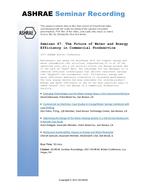In a hot and humid climate, the year-round wetting of cooling coils and drain pans make them ideal breeding grounds for microorganisms, which mayhave adverse effects on indoor air quality (IAQ). Ultraviolet coil irradiation systems are marketed on the basis of claims that they will improve coilperformance, save energy and improve IAQ. The disinfection performance of a coil irradiation system was investigated via a field study. A commerciallyavailable coil irradiation system was installed on the downstream side of a cooling coil in a variable air volume (VAV) air handling unit (AHU)serving a library building. The disinfection performance was assessed by a “before” and “after” irradiation comparison of bio-contamination level on coilsurfaces. Surface biological samples were collected from both upstream and downstream side coil fin surfaces based on a 2 × 3 sampling grid using spearshapedabsorbent swabs. Seven samplings were conducted (two before irradiation and five after irradiation) throughout the study. The measurements takenshowed that 1) the coil irradiation system is able to rapidly eliminate fungi on downstream coil surfaces; 2) 10 weeks may not adequate to disinfectupstream coil surfaces; 3) the coil under investigation is mainly contaminated by fungi during normal operation with heavier fungal contaminationoccurring on upstream coil surfaces;. The above observations suggest that coil irradiation systems may be effective in disinfecting coil surfaces in a hot andhumid climate.
Citation: ASHRAE and AIVC IAQ 2016 Conf
Product Details
- Published:
- 2016
- Number of Pages:
- 8
- Units of Measure:
- Dual
- File Size:
- 1 file , 910 KB
- Product Code(s):
- D-2016IAQ-12


